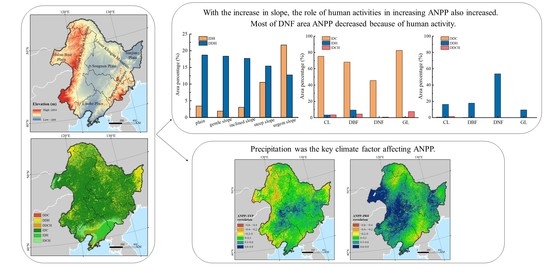Vegetation Productivity Dynamics in Response to Climate Change and Human Activities under Different Topography and Land Cover in Northeast China
Abstract
:1. Introduction
2. Materials and Methods
2.1. Study Area
2.2. Data Sources
2.2.1. Remote Sensing Data
2.2.2. Meteorological Data
2.2.3. FLUXNET Data
2.3. Methods
2.3.1. NPP Estimation
2.3.2. R/S Analysis
2.3.3. Partial Correlation Analysis
2.3.4. Convert GPP to NPP
3. Results
3.1. Validation of Simulated ANPP
3.2. Spatial Characteristics of NPP from 2001 to 2019
3.2.1. Spatial Distribution of ANPP
3.2.2. ANPP, PNPP and HNPP Trends
3.3. Relative Influences of Climate Change and Human Activities on Vegetation Productivity
3.3.1. Influences of Climate Change and Human Activity on Vegetation ANPP Dynamics
3.3.2. Analysis of Driving Factors for Different Vegetation Types
3.3.3. Analysis of the Driving Factors in Different Topographic Elements
3.4. The Relationship between Vegetation ANPP and Climate Factors
4. Discussion
4.1. ANPP Change Characteristics in NEC
4.2. Role of Climate Change in Determining ANPP
4.3. Role of Human Activities in Determining ANPP
4.4. Limitations of This Study
5. Conclusions
- The average ANPP of the entire study area was 477.90 g C m−2 year−1 from 2001 to 2019, the area of increased ANPP accounted for 81.62% of NEC, and the area of decreased ANPP was mainly distributed across the eastern Sanjiang Plain, southern Liaohe Plain, and DNFs. According to the analysis of the Hurst exponent, the ANPP change exhibited a certain sustainability, and the ANPP in 72.23% of the study area will increase in the future.
- Compared with human activities, climate change has a greater influence on ANPP, which promoted the increase in ANPP in 71.55% of the study area. In addition, the influences of climate factors (temperature and precipitation) on ANPP have spatial differences. ANPP in the western part of the study area was negatively correlated with temperature because of less precipitation. ANPP was negatively correlated with precipitation in the Greater Khingan Mountains and Changbai Mountains. In the western grasslands, northern Greater Khingan Mountains, and eastern Songnen Plain, ANPP decreased with intensified human activities. In the southern Changbai Mountains, ANPP increased due to human activities.
- Compared with other vegetation types, DNF was most affected by human activities, and ANPP in 53.84% of the DNF area decreased because of human activities. In different topography, the impact of human activities on vegetation productivity was also different; with increasing slope, the contribution rate of human activities to the increase in ANPP also increased, while the effects had no obvious distinction at different altitude grades.
Author Contributions
Funding
Institutional Review Board Statement
Informed Consent Statement
Data Availability Statement
Acknowledgments
Conflicts of Interest
References
- Intergovernmental Panel on Climate Change. Climate Change 2013: The Physical Science Basis. Contribution of Working Group I to the Fifth Assessment Report of the Intergovernmental Panel on Climate Change; Cambridge University Press: Cambridge, UK; New York, NY, USA, 2013. [Google Scholar]
- Zhao, M.; Running, S.W. Drought-Induced Reduction in Global Terrestrial Net Primary Production from 2000 Through 2009. Science 2010, 329, 940–943. [Google Scholar] [CrossRef] [Green Version]
- Cumming, G.S.; Buerkert, A.; Hoffmann, E.M.; Schlecht, E.; von Cramon-Taubadel, S.; Tscharntke, T. Implications of agricultural transitions and urbanization for ecosystem services. Nature 2014, 515, 50–57. [Google Scholar] [CrossRef] [PubMed]
- Newbold, T.; Hudson, L.N.; Hill, S.L.L.; Contu, S.; Lysenko, I.; Senior, R.A.; Boerger, L.; Bennett, D.J.; Choimes, A.; Collen, B.; et al. Global effects of land use on local terrestrial biodiversity. Nature 2015, 520, 45–50. [Google Scholar] [CrossRef] [Green Version]
- Dirnbock, T.; Dullinger, S.; Grabherr, G. A regional impact assessment of climate and land-use change on alpine vegetation. J. Biogeogr. 2003, 30, 401–417. [Google Scholar] [CrossRef]
- Ye, X.; Zhang, Q.; Liu, J.; Li, X.; Xu, C. Distinguishing the relative impacts of climate change and human activities on variation of streamflow in the Poyang Lake catchment, China. J. Hydrol. 2013, 494, 83–95. [Google Scholar] [CrossRef]
- Li, C.; Qi, J.; Yang, L.; Wang, S.; Yang, W.; Zhu, G.; Zou, S.; Zhang, F. Regional vegetation dynamics and its response to climate change—A case study in the Tao River Basin in Northwestern China. Environ. Res. Lett. 2014, 9, 125003. [Google Scholar] [CrossRef]
- Liu, Y.; Zhang, Z.; Tong, L.; Khalifa, M.; Wang, Q.; Gang, C.; Wang, Z.; Li, J.; Sun, Z. Assessing the effects of climate variation and human activities on grassland degradation and restoration across the globe. Ecol. Indic. 2019, 106, 105504. [Google Scholar] [CrossRef]
- Wang, H.; Sun, B.; Yu, X.; Xin, Z.; Jia, G. The driver-pattern-effect connection of vegetation dynamics in the transition area between semi-arid and semi-humid northern China. Catena 2020, 194, 104713. [Google Scholar] [CrossRef]
- Wang, B.; Xu, G.; Li, P.; Li, Z.; Zhang, Y.; Cheng, Y.; Jia, L.; Zhang, J. Vegetation dynamics and their relationships with climatic factors in the Qinling Mountains of China. Ecol. Indic. 2020, 108, 105719. [Google Scholar] [CrossRef]
- Huete, A. Ecology: Vegetation’s responses to climate variability. Nature 2016, 531, 181–182. [Google Scholar] [CrossRef]
- Deng, G.; Zhang, H.; Guo, X.; Shan, Y.; Ying, H.; Rihan, W.; Li, H.; Han, Y. Asymmetric Effects of Daytime and Nighttime Warming on Boreal Forest Spring Phenology. Remote Sens. 2019, 11, 1651. [Google Scholar] [CrossRef] [Green Version]
- Wang, C.; Jiang, Q.o.; Deng, X.; Lv, K.; Zhang, Z. Spatio-Temporal Evolution, Future Trend and Phenology Regularity of Net Primary Productivity of Forests in Northeast China. Remote Sens. 2020, 12, 3670. [Google Scholar] [CrossRef]
- Li, A.; Wu, J.; Huang, J. Distinguishing between human-induced and climate-driven vegetation changes: A critical application of RESTREND in inner Mongolia. Landsc. Ecol. 2012, 27, 969–982. [Google Scholar] [CrossRef]
- Zhang, Y.; Zhang, C.; Wang, Z.; Chen, Y.; Gang, C.; An, R.; Li, J. Vegetation dynamics and its driving forces from climate change and human activities in the Three-River Source Region, China from 1982 to 2012. Sci. Total Environ. 2016, 563, 210–220. [Google Scholar] [CrossRef] [PubMed]
- Li, D.; Xu, D.; Wang, Z.; You, X.; Zhang, X.; Song, A. The dynamics of sand-stabilization services in Inner Mongolia, China from 1981 to 2010 and its relationship with climate change and human activities. Ecol. Indic. 2018, 88, 351–360. [Google Scholar] [CrossRef]
- Chen, T.; Bao, A.; Jiapaer, G.; Guo, H.; Zheng, G.; Jiang, L.; Chang, C.; Tuerhanjiang, L. Disentangling the relative impacts of climate change and human activities on arid and semiarid grasslands in Central Asia during 1982–2015. Sci. Total Environ. 2019, 653, 1311–1325. [Google Scholar] [CrossRef]
- Chen, B.; Zhang, X.; Tao, J.; Wu, J.; Wang, J.; Shi, P.; Zhang, Y.; Yu, C. The impact of climate change and anthropogenic activities on alpine grassland over the Qinghai-Tibet Plateau. Agric. For. Meteorol. 2014, 189, 11–18. [Google Scholar] [CrossRef]
- Mu, S.; Zhou, S.; Chen, Y.; Li, J.; Ju, W.; Odeh, I.O.A. Assessing the impact of restoration-induced land conversion and management alternatives on net primary productivity in Inner Mongolian grassland, China. Glob. Planet. Change 2013, 108, 29–41. [Google Scholar] [CrossRef]
- Zhang, F.; Zhang, Z.; Kong, R.; Chang, J.; Tian, J.; Zhu, B.; Jiang, S.; Chen, X.; Xu, C.-Y. Changes in Forest Net Primary Productivity in the Yangtze River Basin and Its Relationship with Climate Change and Human Activities. Remote Sens. 2019, 11, 1451. [Google Scholar] [CrossRef] [Green Version]
- Jiang, H.; Xu, X.; Guan, M.; Wang, L.; Huang, Y.; Jiang, Y. Determining the contributions of climate change and human activities to vegetation dynamics in agro-pastural transitional zone of northern China from 2000 to 2015. Sci. Total Environ. 2020, 718, 134871. [Google Scholar] [CrossRef]
- Ugbaje, S.U.; Odeh, I.O.A.; Bishop, T.F.A.; Li, J. Assessing the spatio-temporal variability of vegetation productivity in Africa: Quantifying the relative roles of climate variability and human activities. Int. J. Digit. Earth 2017, 10, 879–900. [Google Scholar] [CrossRef]
- Haberl, H.; Erb, K.H.; Krausmann, F.; Gaube, V.; Bondeau, A.; Plutzar, C.; Gingrich, S.; Lucht, W.; Fischer-Kowalski, M. Quantifying and mapping the human appropriation of net primary production in earth’s terrestrial ecosystems. Proc. Natl. Acad. Sci. USA 2007, 104, 12942–12945. [Google Scholar] [CrossRef] [PubMed] [Green Version]
- Xu, D.Y.; Kang, X.W.; Zhuang, D.F.; Pan, J.J. Multi-scale quantitative assessment of the relative roles of climate change and human activities in desertification—A case study of the Ordos Plateau, China. J. Arid Environ. 2010, 74, 498–507. [Google Scholar] [CrossRef]
- Naeem, S.; Zhang, Y.; Tian, J.; Qamer, F.M.; Latif, A.; Paul, P.K. Quantifying the Impacts of Anthropogenic Activities and Climate Variations on Vegetation Productivity Changes in China from 1985 to 2015. Remote Sens. 2020, 12, 1113. [Google Scholar] [CrossRef] [Green Version]
- Ren, G.; Ding, Y.; Zhao, Z.; Zheng, J.; Wu, T.; Tang, G.; Xu, Y. Recent progress in studies of climate change in China. Adv. Atmos. Sci. 2012, 29, 958–977. [Google Scholar] [CrossRef]
- Wang, C.; Jiang, Q.o.; Engel, B.; Mercado, J.A.V.; Zhang, Z. Analysis on net primary productivity change of forests and its multi–level driving mechanism—A case study in Changbai Mountains in Northeast China. Technol. Forecast. Soc. Chang. 2020, 153, 119939. [Google Scholar] [CrossRef]
- Hu, Q.; Pan, X.; Shao, C.; Zhang, D.; Wang, X.; Wei, X. Distribution and Variation of China Agricultural Heat Resources in 1961–2010. Chin. J. Agrometeorol. 2014, 35, 119–127. (In Chinese) [Google Scholar]
- Li, K.; Tong, Z.; Liu, X.; Zhang, J.; Tong, S. Quantitative assessment and driving force analysis of vegetation drought risk to climate change:Methodology and application in Northeast China. Agric. For. Meteorol. 2020, 282, 107865. [Google Scholar] [CrossRef]
- He, B.; Lue, A.; Wu, J.; Zhao, L.; Liu, M. Drought hazard assessment and spatial characteristics analysis in China. J. Geogr. Sci. 2011, 21, 235–249. [Google Scholar] [CrossRef]
- Jiang, S.; Wang, J.; Zhao, Y.; Shang, Y.; Gao, X.; Li, H.; Wang, Q.; Zhu, Y. Sustainability of water resources for agriculture considering grain production, trade and consumption in China from 2004 to 2013. J. Clean Prod. 2017, 149, 1210–1218. [Google Scholar] [CrossRef] [Green Version]
- Mao, D.; Wang, Z.; Wu, J.; Wu, B.; Zeng, Y.; Song, K.; Yi, K.; Luo, L. China’s wetlands loss to urban expansion. Land Degrad. Dev. 2018, 29, 2644–2657. [Google Scholar] [CrossRef]
- Mao, D.; He, X.; Wang, Z.; Tian, Y.; Xiang, H.; Yu, H.; Man, W.; Jia, M.; Ren, C.; Zheng, H. Diverse policies leading to contrasting impacts on land cover and ecosystem services in Northeast China. J. Clean Prod. 2019, 240, 117961. [Google Scholar] [CrossRef]
- Mao, D.; Wang, Z.; Luo, L.; Ren, C. Integrating AVHRR and MODIS data to monitor NDVI changes and their relationships with climatic parameters in Northeast China. Int. J. Appl. Earth Obs. Geoinf. 2012, 18, 528–536. [Google Scholar] [CrossRef]
- Geng, R.; Zhao, Y.; Cui, Q.; Qin, F. Representation of modern pollen assemblages with respect to vegetation and climate in Northeast China. Quat. Int. 2019, 532, 126–137. [Google Scholar] [CrossRef]
- Xin, F.; Xiao, X.; Dong, J.; Zhang, G.; Zhang, Y.; Wu, X.; Li, X.; Zou, Z.; Ma, J.; Du, G.; et al. Large increases of paddy rice area, gross primary production, and grain production in Northeast China during 2000–2017. Sci. Total Environ. 2020, 711, 135183. [Google Scholar] [CrossRef]
- Zhou, H.; Yue, X.; Lei, Y.; Zhang, T.; Tian, C.; Ma, Y.; Cao, Y. Responses of gross primary productivity to diffuse radiation at global FLUXNET sites. Atmos. Environ. 2021, 244, 117905. [Google Scholar] [CrossRef]
- Potter, C.S.; Randerson, J.T.; Field, C.B.; Matson, P.A.; Vitousek, P.M.; Mooney, H.A.; Klooster, S.A. Terrestrial Ecosystem Production: A Process Model Based on Global Satellite and Surface Data. Glob. Biogeochem. Cycle 1993, 7, 811–841. [Google Scholar] [CrossRef]
- Zhu, W.Q.; Pan, Y.Z.; He, H.; Yu, D.Y.; Hu, H.B. Simulation of maximum light use efficiency for some typical vegetation types in China. Chin. Sci. Bull. 2006, 51, 457–463. [Google Scholar] [CrossRef]
- Lieth, H. Modeling the primary productivity of the world. Nat. Resour. 1972, 8, 5–10. [Google Scholar]
- Hurst, H. Long Term Storage Capacity of Reservoirs. Trans. Am. Soc. Civil Eng. 1951, 116, 770–799. [Google Scholar] [CrossRef]
- Wang, Y.; Liu, X.; Ren, G.; Yang, G.; Feng, Y. Analysis of the spatiotemporal variability of droughts and the effects of drought on potato production in northern China. Agric. For. Meteorol. 2019, 264, 334–342. [Google Scholar] [CrossRef]
- Wu, D.; Zhao, X.; Liang, S.; Zhou, T.; Huang, K.; Tang, B.; Zhao, W. Time-lag effects of global vegetation responses to climate change. Glob. Change Biol. 2015, 21, 3520–3531. [Google Scholar] [CrossRef] [PubMed]
- Liu, Y.; Yang, Y.; Wang, Q.; Du, X.; Li, J.; Gang, C.; Zhou, W.; Wang, Z. Evaluating the responses of net primary productivity and carbon use efficiency of global grassland to climate variability along an aridity gradient. Sci. Total Environ. 2019, 652, 671–682. [Google Scholar] [CrossRef]
- Dewar, R.C.; Medlyn, B.E.; McMurtrie, R.E. A mechanistic analysis of light and carbon use efficiencies. Plant Cell Environ. 1998, 21, 573–588. [Google Scholar] [CrossRef]
- Gifford, R.M. Plant respiration in productivity models: Conceptualisation, representation and issues for global terrestrial carbon-cycle research. Funct. Plant Biol. 2003, 30, 171–186. [Google Scholar] [CrossRef] [PubMed]
- Waring, R.H.; Landsberg, J.J.; Williams, M. Net primary production of forests: A constant fraction of gross primary production? Tree Physiol. 1998, 18, 129–134. [Google Scholar] [CrossRef] [PubMed]
- Zeng, Y.; Yang, X.; Fang, N.; Shi, Z. Large-scale afforestation significantly increases permanent surface water in China’s vegetation restoration regions. Agric. For. Meteorol. 2020, 290, 108001. [Google Scholar] [CrossRef]
- Tao, F.; Zhang, Z. Dynamic responses of terrestrial ecosystems structure and function to climate change in China. J. Geophys. Res. 2010, 115, G03003. [Google Scholar] [CrossRef]
- Tian, Z.; Xu, H.; Sun, L.; Fan, D.; Fischer, G.; Zhong, H.; Zhang, P.; Pope, E.; Kent, C.; Wu, W. Using a cross-scale simulation tool to assess future maize production under multiple climate change scenarios: An application to the Northeast Farming Region of China. Clim. Serv. 2020, 18, 100150. [Google Scholar] [CrossRef]
- Sun, G.; Mu, M. Assessing the characteristics of net primary production due to future climate change and CO2 under RCP4.5 in China. Ecol. Complex. 2018, 34, 58–68. [Google Scholar] [CrossRef]
- Jiapaer, G.; Liang, S.; Yi, Q.; Liu, J. Vegetation dynamics and responses to recent climate change in Xinjiang using leaf area index as an indicator. Ecol. Indic. 2015, 58, 64–76. [Google Scholar]
- Wang, J.; Rich, P.M.; Price, K.P. Temporal responses of NDVI to precipitation and temperature in the central Great Plains, USA. Int. J. Remote Sens. 2003, 24, 2345–2364. [Google Scholar] [CrossRef]
- Horion, S.; Cornet, Y.; Erpicum, M.; Tychon, B. Studying interactions between climate variability and vegetation dynamic using a phenology based approach. Int. J. Appl. Earth Obs. Geoinf. 2013, 20, 20–32. [Google Scholar] [CrossRef]
- Lu, N.; Wilske, B.; Ni, J.; John, R.; Chen, J. Climate change in Inner Mongolia from 1955 to 2005—trends at regional, biome and local scales. Environ. Res. Lett. 2009, 4, 045006. [Google Scholar] [CrossRef] [Green Version]
- Mowll, W.; Blumenthal, D.M.; Cherwin, K.; Smith, A.; Symstad, A.J.; Vermeire, L.T.; Collins, S.L.; Smith, M.D.; Knapp, A.K. Climatic controls of aboveground net primary production in semi-arid grasslands along a latitudinal gradient portend low sensitivity to warming. Oecologia 2015, 177, 959–969. [Google Scholar] [CrossRef] [PubMed] [Green Version]
- Zeng, B.; Yang, T. Impacts of climate warming on vegetation in Qaidam Area from 1990 to 2003. Environ. Monit. Assess. 2008, 144, 403–417. [Google Scholar] [CrossRef] [PubMed]
- Chen, Y.; Mu, S.; Sun, Z.; Gang, C.; Li, J.; Padarian, J.; Groisman, P.; Chen, J.; Li, S. Grassland Carbon Sequestration Ability in China: A New Perspective from Terrestrial Aridity Zones. Rangel. Ecol. Manag. 2016, 69, 84–94. [Google Scholar] [CrossRef]
- Song, Y.; Ma, M. Variation of AVHRR NDVI and its Relationship with Climate in Chinese Arid and Cold Regions. J. Remote Sens. 2008, 12, 499–505. (In Chinese) [Google Scholar]
- Zhang, Y.; Peng, C.; Li, W.; Tian, L.; Zhu, Q.; Chen, H.; Fang, X.; Zhang, G.; Liu, G.; Mu, X.; et al. Multiple afforestation programs accelerate the greenness in the ‘Three North’ region of China from 1982 to 2013. Ecol. Indic. 2016, 61, 404–412. [Google Scholar] [CrossRef]
- Fu, B.J.; Liu, S.L.; Ma, K.M.; Zhu, Y.G. Relationships between soil characteristics, topography and plant diversity in a heterogeneous deciduous broad-leaved forest near Beijing, China. Plant Soil 2004, 261, 47–54. [Google Scholar] [CrossRef]
- Cheng, Y.; Li, P.; Xu, G.; Li, Z.; Gao, H.; Zhao, B.; Wang, T.; Wang, F.; Cheng, S. Effects of soil erosion and land use on spatial distribution of soil total phosphorus in a small watershed on the Loess Plateau, China. Soil Tillage Res. 2018, 184, 142–152. [Google Scholar] [CrossRef]
- Liu, Z.; Yang, J.; Chang, Y.; Weisberg, P.J.; He, H.S. Spatial patterns and drivers of fire occurrence and its future trend under climate change in a boreal forest of Northeast China. Glob. Change Biol. 2012, 18, 2041–2056. [Google Scholar] [CrossRef]
- Yang, G.; Shu, L.F.; Di, X.Y. Prediction on the changes of forest fire danger rating in Great Xing’an Mountain region of Northeast China in the 21st century under effects of climate change. Chin. J. Appl. Ecol. 2012, 23, 3236–3242. (In Chinese) [Google Scholar]
- Prăvălie, R.; Patriche, C.; Tişcovschi, A.; Dumitraşcu, M.; Săvulescu, I.; Sîrodoev, I.; Bandoc, G. Recent spatio-temporal changes of land sensitivity to degradation in Romania due to climate change and human activities: An approach based on multiple environmental quality indicators. Ecol. Indic. 2020, 118, 106755. [Google Scholar] [CrossRef]
- Liu, X.; Dong, G.; Xue, Z.; Lu, X.; Jiang, M.; Zhang, Y. Carbon sequestration potential change after marshlands conversion to croplands in the Northeast China between 1982 and 2010. Ecol. Eng. 2014, 70, 402–405. [Google Scholar] [CrossRef]
- Tian, J.; Wang, B.; Zhang, C.; Li, W.; Wang, S. Mechanism of regional land use transition in underdeveloped areas of China: A case study of northeast China. Land Use Policy 2020, 94, 104538. [Google Scholar] [CrossRef]
- Liu, X.; Dong, G.; Wang, X.; Xue, Z.; Jiang, M.; Lu, X.; Zhang, Y. Characterizing the spatial pattern of marshlands in the Sanjiang Plain, Northeast China. Ecol. Eng. 2013, 53, 335–342. [Google Scholar] [CrossRef]
- Chen, H.; Zhang, W.; Gao, H.; Nie, N. Climate Change and Anthropogenic Impacts on Wetland and Agriculture in the Songnen and Sanjiang Plain, Northeast China. Remote Sens. 2018, 10, 356. [Google Scholar] [CrossRef] [Green Version]
- Wang, L.L.; Song, C.C.; Ge, R.J.; Song, Y.Y.; Liu, D.Y. Soil organic carbon storage under different land-use types in Sanjiang Plain. China Environ. Sci. 2009, 29, 656–660. (In Chinese) [Google Scholar]
- Piao, S.; Fang, J.; He, J. Variations in Vegetation Net Primary Production in the Qinghai-Xizang Plateau, China, from 1982 to 1999. Clim. Change 2006, 74, 253–267. [Google Scholar] [CrossRef]

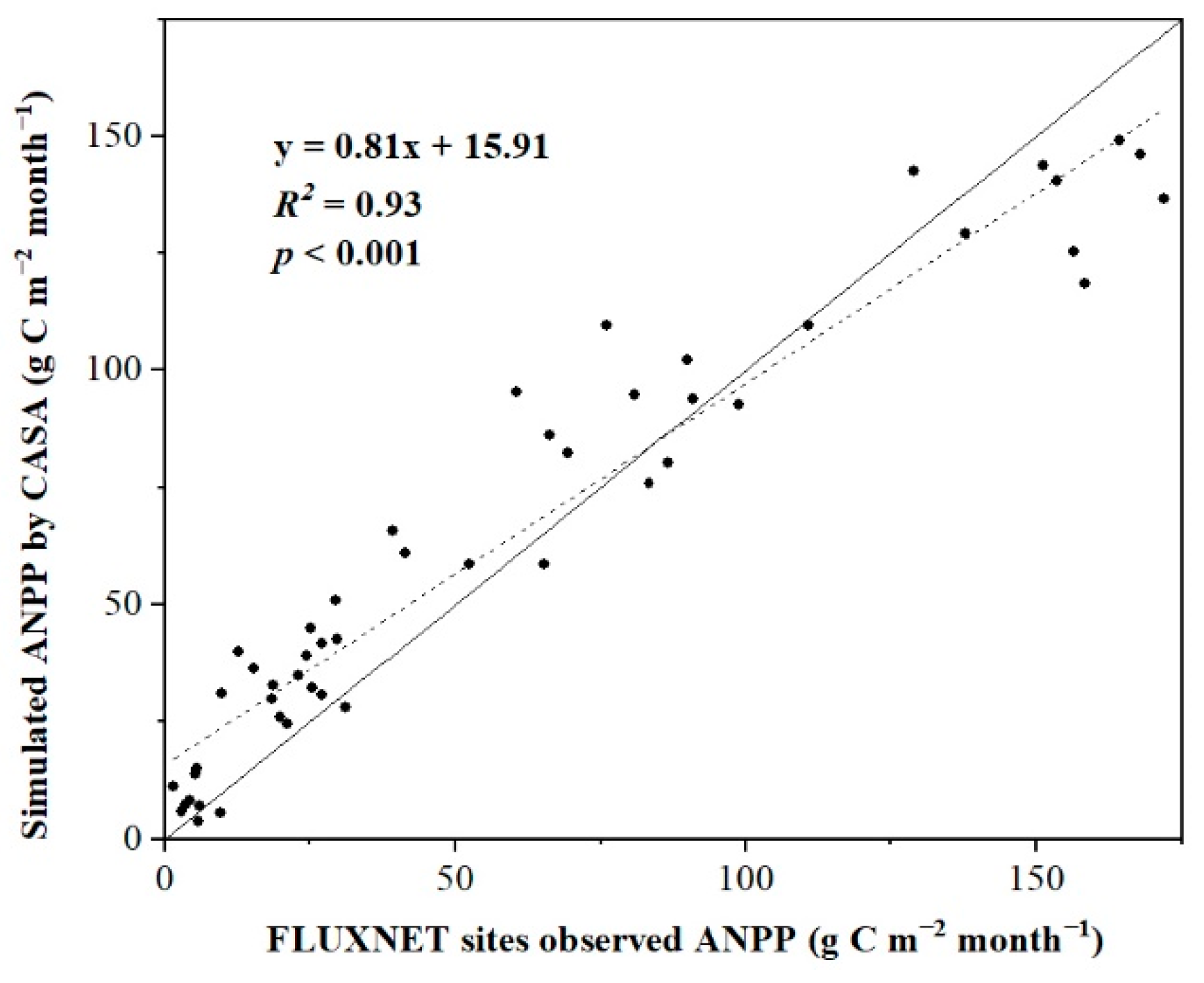
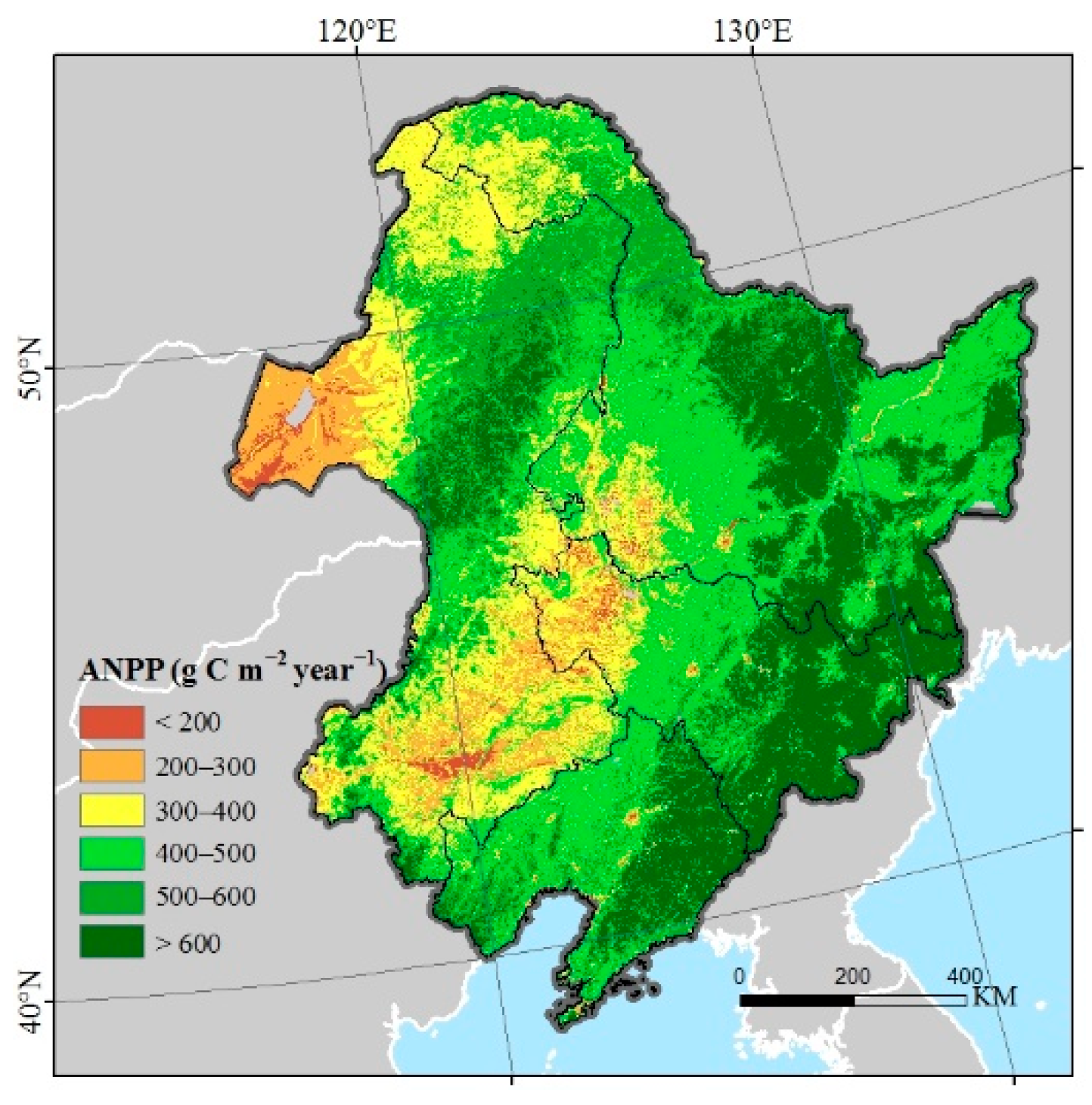

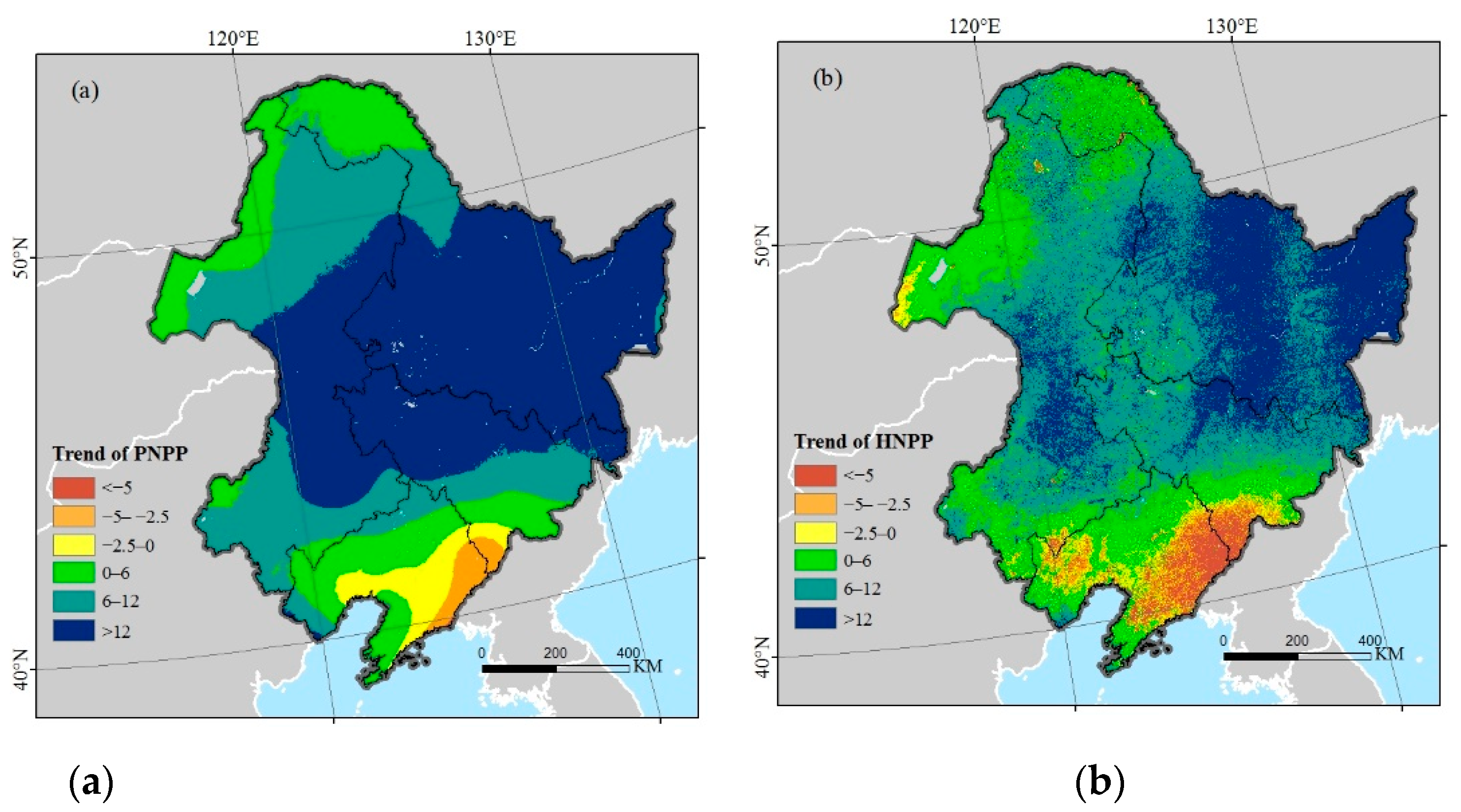


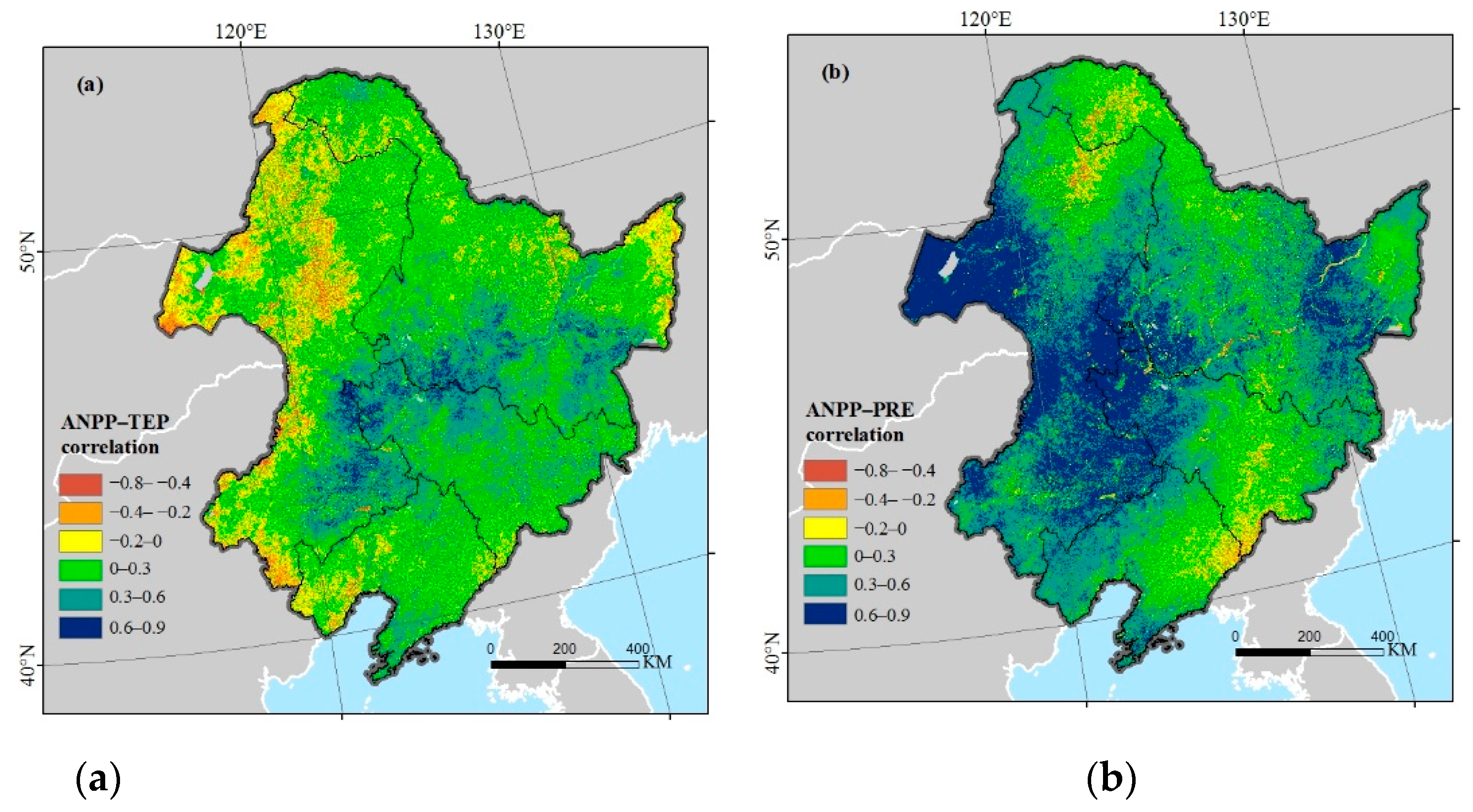

| SANPP | SPNPP | SHNPP | Driving Factors of ANPP |
|---|---|---|---|
| + | + | + | Increase due to climate change (IDC) |
| + | − | − | Increase due to human activities (IDH) |
| + | + | − | Increase due to the combined influences of climate change and human activities (IDCH) |
| − | − | − | Decrease due to climate change (DDC) |
| − | + | + | Decrease due to human activities (DDH) |
| − | − | + | Decrease due to the combined influences of climate change and human activities (DDCH) |
| Land | Area | Translates to | |||||||||||
|---|---|---|---|---|---|---|---|---|---|---|---|---|---|
| Cover | Grass | Crop | DNF | DBF | Others | Change | |||||||
| Area | % | Area | % | Area | % | Area | % | Area | % | Area | % | ||
| Grass | 362.67 | 301.21 | 83.05 | 39.13 | 10.80 | 0.69 | 0.19 | 20.29 | 5.59 | 1.35 | 0.37 | 61.46 | 16.95 |
| Crops | 390.11 | 15.01 | 3.85 | 354.41 | 90.85 | 0.03 | 0.00 | 19.30 | 4.95 | 1.36 | 0.35 | 35.70 | 9.15 |
| DNF | 74.30 | 0.72 | 0.97 | 0.01 | 0.00 | 63.62 | 85.63 | 9.75 | 13.12 | 0.20 | 0.28 | 10.68 | 14.37 |
| DBF | 388.56 | 7.15 | 2.35 | 6.00 | 1.54 | 9.73 | 2.50 | 363.46 | 93.54 | 0.22 | 0.07 | 25.1 | 6.46 |
| Altitude | Mean | Area Percentage (%) | Influence Factors (%) | |||||||||
|---|---|---|---|---|---|---|---|---|---|---|---|---|
| (m) | ANPP | CL | DBF | DNF | GL | IDC | IDH | IDCH | DDC | DDH | DDCH | Total |
| ≤200 | 432.22 | 63.73 | 5.1 | 0.39 | 19.12 | 70.78 | 4.7 | 3.63 | 0.83 | 18.37 | 1.69 | 100 |
| 200~500 | 509.81 | 32.69 | 46.88 | 9.05 | 24.3 | 73.31 | 5.01 | 5.2 | 0.16 | 16.2 | 0.12 | 100 |
| 500~1000 | 484.24 | 3.33 | 42.01 | 76.36 | 46.65 | 70.56 | 3.75 | 8.16 | 0.05 | 17.46 | 0.02 | 100 |
| >1000 | 511.04 | 0.25 | 6.01 | 14.2 | 9.93 | 69.81 | 0.77 | 7.39 | 0.02 | 22 | 0.01 | 100 |
| Total | 100 | 100 | 100 | 100 | 100 | |||||||
| Slope | Mean | Area Percentage (%) | Influence Factors (%) | |||||||||
|---|---|---|---|---|---|---|---|---|---|---|---|---|
| (°) | ANPP | CL | DBF | DNF | GL | IDC | IDH | IDCH | DDC | DDH | DDCH | Total |
| ≤2 | 421.09 | 13.05 | 3.87 | 3.87 | 11.61 | 71.13 | 3.44 | 4.33 | 0.74 | 18.72 | 1.64 | 100 |
| 2~5 | 434.80 | 35.52 | 15.88 | 16.57 | 33.22 | 74.65 | 1.91 | 4.04 | 0.32 | 18.4 | 0.68 | 100 |
| 5~15 | 484.53 | 46.1 | 51.62 | 55.82 | 45.39 | 72.78 | 3.05 | 5.96 | 0.19 | 17.71 | 0.31 | 100 |
| 15~25 | 572.38 | 4.71 | 22.32 | 19.23 | 7.98 | 64.59 | 10.57 | 8.83 | 0.31 | 15.43 | 0.27 | 100 |
| >25 | 611.09 | 0.62 | 6.31 | 4.51 | 1.8 | 53.9 | 21.74 | 10.76 | 0.55 | 12.74 | 0.31 | 100 |
| Total | 100 | 100 | 100 | 100 | ||||||||
Publisher’s Note: MDPI stays neutral with regard to jurisdictional claims in published maps and institutional affiliations. |
© 2021 by the authors. Licensee MDPI, Basel, Switzerland. This article is an open access article distributed under the terms and conditions of the Creative Commons Attribution (CC BY) license (http://creativecommons.org/licenses/by/4.0/).
Share and Cite
Li, H.; Zhang, H.; Li, Q.; Zhao, J.; Guo, X.; Ying, H.; Deng, G.; Rihan, W.; Wang, S. Vegetation Productivity Dynamics in Response to Climate Change and Human Activities under Different Topography and Land Cover in Northeast China. Remote Sens. 2021, 13, 975. https://doi.org/10.3390/rs13050975
Li H, Zhang H, Li Q, Zhao J, Guo X, Ying H, Deng G, Rihan W, Wang S. Vegetation Productivity Dynamics in Response to Climate Change and Human Activities under Different Topography and Land Cover in Northeast China. Remote Sensing. 2021; 13(5):975. https://doi.org/10.3390/rs13050975
Chicago/Turabian StyleLi, Hui, Hongyan Zhang, Qixin Li, Jianjun Zhao, Xiaoyi Guo, Hong Ying, Guorong Deng, Wu Rihan, and Shuling Wang. 2021. "Vegetation Productivity Dynamics in Response to Climate Change and Human Activities under Different Topography and Land Cover in Northeast China" Remote Sensing 13, no. 5: 975. https://doi.org/10.3390/rs13050975
APA StyleLi, H., Zhang, H., Li, Q., Zhao, J., Guo, X., Ying, H., Deng, G., Rihan, W., & Wang, S. (2021). Vegetation Productivity Dynamics in Response to Climate Change and Human Activities under Different Topography and Land Cover in Northeast China. Remote Sensing, 13(5), 975. https://doi.org/10.3390/rs13050975







